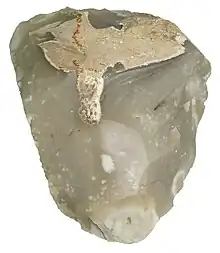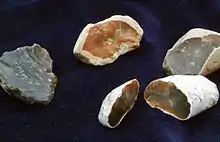燧石
燧石俗称火石,是一种比较常见的硅质岩石[1],主要由隐晶质石英(SiO2)组成[2],致密、坚硬,多为灰、黑色,敲碎后具有贝壳状断口,根据其存在状态,分为两种类型:
- 层状燧石:多与含磷和含锰的黏土层共生,分层存在,单层厚度不大,但总厚度可达几百公尺,有块状和鲕状的区别。
- 结核状燧石:多产于石灰岩中,有球状、卵状、棒状、盘状、葫芦状、不规则状等结核体,一般只有5-15厘米,大的可达1-2米。

發現於摩爾達維亞高原白堊泥灰森諾曼期岩層的燧石

不同的燧石
.jpg.webp)
用燧石制造的石斧
燧石由于坚硬,破碎后产生锋利的断口,所以是最早为石器时代的原始人所青睐,绝大部分石器都是用燧石打击制造的,燧石和铁器击打会产生火花,所以也为古代人用作取火工具,中国古代常用一小块燧石和一把钢制的“火镰”击打取火,所以燧石也叫作火石,燧石槍也是利用扳机击打火石引发火药的。现代利用燧石的坚硬性质,将燧石作为研磨的原料。
参考文献
- Flint and Chert (页面存档备份,存于) - quartzpage.de
- General Quartz Information (页面存档备份,存于) - Webmineral.com (page contains java applets depicting 3d molecular structure)
外部連結
维基词典中的词条「」。
- Flint Architecture of East Anglia (页面存档备份,存于) Book by Stephen Hart
- Flintsource.net European Artefacts - detailed site (页面存档备份,存于)
- Flint circles and paramoudra - Beeston Bump (页面存档备份,存于)
- Paramoudras and flint circles photograph collection
- Winchester Cathedral Close
- Flint and the Conservation of Flint Buildings (页面存档备份,存于) Introduction to the historical use of flint in construction and the repair and conservation of historic flint buildings
This article is issued from Wikipedia. The text is licensed under Creative Commons - Attribution - Sharealike. Additional terms may apply for the media files.